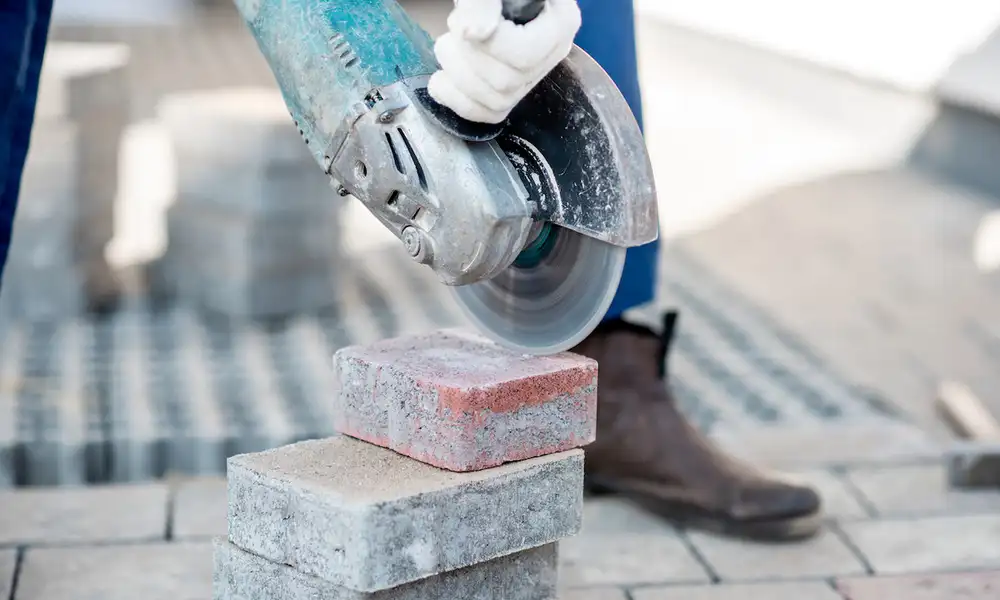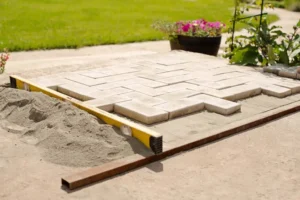How to cut pavers is a crucial skill for achieving a clean, professional finish in outdoor hardscape projects. Pavers commonly made of concrete, brick, or stone are used to create durable and visually appealing surfaces for driveways, patios, walkways, and more. Whether you’re cutting concrete pavers to fit tight corners or need to cut a paver for curved edges, precision matters for both function and aesthetics.
Poor cuts can lead to uneven gaps, instability, or a sloppy appearance. Essential tools, detailed cutting methods, and safety advice will all be covered in this guide. We’ll also cover when it’s best to call in a professional for more complex jobs.
Tools Needed to Cut Pavers

The proper instruments are necessary for precise, clean cuts. Depending on the material and type of cut, you may need one or more of the following:
- Hammer and Chisel – Ideal for simple or rough cuts on brick pavers.
- Circular Saw with Diamond Blade – Great for straight, precise cuts on concrete and stone pavers.
- Angle Grinder – Useful for detailed work and cutting curves.
- Wet Saw – Best for cutting concrete pavers with minimal dust and maximum precision.
Safety Gear
Always prioritize safety when you cut a paver:
- Goggles – To protect eyes from flying debris.
- Gloves – To ensure a firm grip and avoid injuries.
- Dust Mask – To prevent inhaling harmful dust, especially when dry cutting.
A safer and more efficient cutting process is guaranteed when the right equipment and instruments are used.
How to Cut Pavers (Step-by-Step Guide)
Cutting pavers correctly ensures a clean finish and proper fit for your landscape project. Whether you’re installing a patio, walkway, or driveway, follow these steps for professional results.
Step 1: Measure and Mark the Paver
Measure the space where the paver will be placed before you start cutting it. Mark the cut line on the paver clearly using a chalk line or straight edge. To guarantee a smooth fit, precise measurements are essential.
Step 2: Choose the Right Tool Based on the Cut Type and Material
The tool you select depends on the material (concrete, brick, stone) and the type of cut (straight, curved, or corner). Common tools for cutting concrete pavers include:
- Angle Grinder – Best for smaller, precise cuts.
- Wet Saw – Ideal for smooth, clean cuts and reduces dust.
- Masonry Saw – Great for heavy-duty or larger projects.
Always use a diamond blade for efficient cut concrete paver results.
Step 3: Secure the Paver Before Cutting
To avoid movement and ensure safety, place the paver on a non-slip surface or clamp it down. A properly fastened paver lowers the chance of chipping or uneven edges and aids in control during the cut.
Step 4: Make the Cut (Dry vs. Wet Cutting Methods)
There are two main methods for paver cutting:
- Dry Cutting: Often done with an angle grinder. It’s faster but produces more dust. Use proper safety gear, including a dust mask and eye protection.
- Wet Cutting: Uses water to cool the blade and minimize dust. This method is cleaner and better for longer or more precise cuts, especially when you cut concrete paver materials.
After cutting, smooth any rough edges with a masonry file or sanding block for a clean finish.
Need help with professional paver installation or landscape design service in San Jose and nearby areas? Contact Lakota Design Group your experts in creating flawless outdoor spaces.
How to Cut Concrete Pavers
Cutting concrete pavers the right way ensures a professional look and long-lasting results in any hardscape project. Because of their durability and density, concrete pavers require the right tools and techniques to make clean, accurate cuts without cracking.
Understanding Concrete Paver Durability and Density
Concrete pavers are incredibly resilient and made to endure years of wear, severe weather, and heavy traffic. However, this same density makes them tougher to cut than brick or natural stone. When performing paver cutting, using the wrong method can lead to cracking, chipping, or uneven edges.
Best Tools for Cutting Concrete Pavers
To cut concrete paver material effectively, use tools that can handle the hardness of concrete:
- Wet Saw with a Diamond Blade
Ideal for clean, smooth, and precise cuts. The use of water helps cool the blade, reduce dust, and minimize the risk of cracks. - Angle Grinder with a Diamond Blade
Perfect for smaller or detailed cuts. It’s more portable and efficient for quick tasks, but produces more dust and requires a steady hand.
Tips for Clean, Straight Cuts and Reducing Cracking
- Score First, Then Cut: For thicker pavers, lightly score the marked line before making a full cut. This helps guide the blade and reduces chipping.
- Secure the Paver: Clamp the paver or place it on a rubber mat to prevent movement during cutting.
- Go Slow and Steady: Rushing the process creates jagged edges and increases the chance of cracks. Let the blade do the work.
- Use Water When Possible: Especially with wet saws, water keeps the blade cool and the cut clean. It also helps reduce airborne silica dust.
- Smooth Edges After Cutting: Use a masonry file or sanding stone to remove sharp edges or imperfections.
You may read Are concrete pavers good for patio?
How to Cut Curves on Brick Pavers

Curves add elegance and fluidity to landscape designs. Whether you’re installing a winding garden path, custom edging, or a circular patio, learning how to cut a paver to fit a curve is essential for a smooth and professional-looking finish.
Why Use Curves in Paver Designs?
Curved lines in paver installations are more than just aesthetic—they:
- Soften hard edges in landscapes
- Create organic flow for walkways and patios
- Enhance visual appeal, especially in garden borders or circular designs
Properly cutting pavers to follow a curve ensures that the design looks intentional, not forced.
Step 1: Mark the Curved Line on the Pavers
Lay your brick pavers in the desired area before cutting. Then:
- Use a flexible ruler, garden hose, or string to trace the curve.
- Mark the cut line clearly with chalk or pencil directly on each paver.
- For tighter curves, mark smaller, incremental changes across multiple pavers.
Accurate marking ensures you only cut a paver where necessary, minimizing waste.
Step 2: Cutting the Curve – Two Effective Methods
Method 1: Angle Grinder (Preferred for Precision)
An angle grinder fitted with a diamond blade allows for greater control along curves.
- Make short, shallow passes along the curve line instead of one deep cut.
- Let the tool do the work—don’t force the blade.
- Be sure to wear safety gear (gloves, goggles, and a dust mask).
Method 2: Score and Snap for Gentle Curves
If a saw isn’t available:
- Make multiple straight cuts along the curve line using a chisel or circular saw.
- Snap off small pieces gradually to shape the curve.
- This method works well for less precise or rustic-style edges.
Step 3: Smooth the Curve
After cutting:
- Use a masonry file or sanding stone to smooth rough edges.
- This not only improves appearance but prevents sharp corners that could chip over time.
Cutting curves takes more time than straight cuts, but the result is a more refined and natural-looking landscape. Whether you’re updating a garden path or customizing patio edges, knowing how to cut a paver for curves will elevate your outdoor design.
When to Require Professional Help
While DIY paver projects can be rewarding, there are times when hiring a professional is not just beneficial but essential. Knowing when to bring in expert help can save you time, money, and costly mistakes.
1. Large-Scale Projects or Intricate Designs
If your project involves extensive square footage, complex curved layouts, custom inlays, or multi-level designs, professional help is strongly recommended. Pros have the skills and tools to ensure clean lines, consistent patterns, and long-term durability something that’s hard to match without experience.
2. Lack of Proper Tools or Experience
To cut a paver cleanly and safely, especially across large batches, you’ll need tools like wet saws, angle grinders, and diamond blades not to mention the expertise to use them correctly. Without the right setup, DIY attempts can lead to poor results, wasted materials, or even injuries.
3. Preventing Waste, Breakage, and Injury
Improper cuts, misaligned patterns, or using the wrong blade can cause excessive paver breakage driving up material costs and project delays. Additionally, cutting pavers creates dust and debris, posing health risks without proper gear and ventilation.
4. Cost-Benefit Analysis: DIY vs. Hiring a Pro
While doing it yourself may seem cost-effective at first, factor in:
- Tool rental or purchase
- Material waste from errors
- Time commitment
- Potential repairs or rework later
Hiring a professional like Lakota Design Group offers peace of mind, quality craftsmanship, and long-term value making it a smarter investment for many homeowners.
Need Expert Help? Let Lakota Design Group Bring Your Vision to Life
From precision paver cutting to full-scale landscape design, we handle every detail with care, experience, and creativity. Whether you’re dealing with complex curves or a large outdoor renovation, our team is ready to get it done right the first time.
Contact Lakota Design Group today for a consultation and discover how we can transform your outdoor space with expert craftsmanship and personalized service.
FAQs
1. Why Would I Need To Cut Curves On Brick Pavers?
Curves are often used in landscaping to create soft, natural lines for garden paths, patio edges, or decorative borders. Cutting curves into brick pavers allows your design to flow with the environment, rather than follow rigid, straight lines.
2. What Tools Are Best For Cutting Curved Lines On Brick Pavers?
The most effective tool for cutting curves is an angle grinder with a diamond blade. For more detailed work, a wet saw can also be used. These tools allow for greater control and precision compared to basic tools like a hammer and chisel.
3. Can I Use A Hammer And Chisel To Cut Curves?
A hammer and chisel can be used for rough or rustic curved cuts, but it’s not ideal for tight or precise curves. This method may result in uneven edges or increased breakage.
4. How Do I Mark A Curve On A Brick Paver Before Cutting?
You can use a flexible guide, such as a garden hose, bendable ruler, or even a string line to trace your desired curve. Then, mark the line with chalk or a grease pencil on each brick that needs to be trimmed.
5. What’s The Best Technique To Cut A Curve On A Brick Paver Using A Saw?
Make multiple small, shallow passes with the saw or angle grinder, slowly following the curve. Avoid deep cuts all at once gradual cutting reduces stress on the paver and ensures a cleaner finish.





